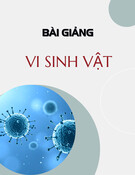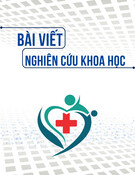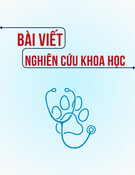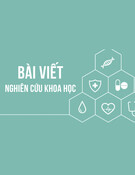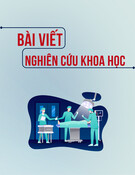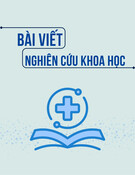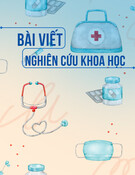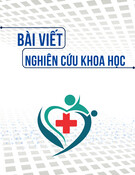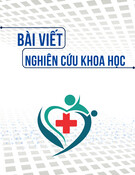
TẠP CHÍ Y HỌC VIỆT NAM TẬP 475 - THÁNG 2 - SỐ 1&2 - 2019
91
TÀI LIỆU THAM KHẢO
1. Nguyễn Lân Việt (2007), Nhồi máu cơ tim cấp,
Bài giảng bệnh học nội khoa
, Nhà xuất bản Y học,
tr. 82 - 94.
2. Widimsky P, Wijns W, Fajadet J, et al. (2010),
"European Association for Percutaneous
Cardiovascular Interventions. Reperfusion therapy
for ST elevation acute myocardial infarction in
Europe: description of the current situation in 30
countries",
Eur Heart J
31 (8), pp. 943–957.
3. Nguyễn Văn Tiến (1998), "Tình hình tử vong ở
bệnh nhân nhồi máu cơ tim",
Tạp chí Tim mạch
học Việt Nam
, (14), tr 3-7.
4. Garg S, Sarno G, Serruys P W, et al. (2011),
"Prediction of 1-year clinical outcomes using the
SYNTAX score in patients with acute ST-segment
elevation myocardial infarction undergoing primary
percutaneous coronary intervention: a substudy of
the STRATEGY (Single High-Dose Bolus Tirofiban
and Sirolimus-Eluting Stent Versus Abciximab and
Bare-Metal Stent in Acute Myocardial Infarction)
and MULTISTRATEGY (Multicenter Evaluation of
Single High-Dose Bolus Tirofiban Versus Abciximab
With Sirolimus-Eluting Stent or Bare-Metal Stent in
Acute Myocardial Infarction Study) trials",
JACC
Cardiovasc Interv
, 4 (1), pp. 66-75.
5. Cetinkal G, Dogan S M, Kocas C, et al. (2016),
"The value of the Clinical SYNTAX Score in
predicting long-term prognosis in patients with ST-
segment elevation myocardial infarction who have
undergone primary percutaneous coronary
intervention",
Coron Artery Dis
, 27 (2), pp. 135-142.
6. Girasis C, Garg S, Raber L, et al. (2011),
"SYNTAX score and Clinical SYNTAX score as
predictors of very long-term clinical outcomes in
patients undergoing percutaneous coronary
interventions: a substudy of SIRolimus-eluting
stent compared with pacliTAXel-eluting stent for
coronary revascularization (SIRTAX) trial",
Eur
Heart J
, 32 (24), pp. 3115-3127.
7. Hara H, Aoki J, Tanabe K, et al. (2013), "Impact
of the clinical syntax score on 5-year clinical outcomes
after sirolimus-eluting stents implantation",
Cardiovasc Interv Ther
, 28 (3), pp. 258-266.
HIỆU QUẢ ĐIỀU TRỊ ISOTRETINOIN TRÊN BỆNH NHÂN TRỨNG CÁ VỪA
VÀ NẶNG TẠI KHOA DA LIỄU–BỆNH VIỆN ĐẠI HỌC Y THÁI BÌNH NĂM 2018
Nguyễn Thị Kim Dung1, Vũ Đình Thám1,
Nguyễn Thị Thương Hoài1, Nguyễn Thị Bích Ngọc2
TÓM TẮT26
Mục tiêu: So sánh hiệu quả trước và sau 8 tuần
điều trị trứng cá mức độ vừa và nặng bằng
Isotretinoin (Acnotin 10mg) đường uống kết hợp bôi
tại ch. Phương pháp: Nghiên cứu cắt ngang mô tả,
tiến cứu. Kết quả: Trong tổng số 35 bệnh nhân tham
gia điều trị, tỷ lệ bệnh nhân mụn trứng cá mức độ vừa
(thời gian bị bệnh trên 12 tháng đã điều trị nhiều theo
chuyên khoa nhưng không cải thiện) chiếm chủ yếu
65,7%. Triệu chứng lâm sàng phổ biến nhất gặp trên
nhóm bệnh nhân tham gia nghiên cứu là da nhờn
(88,6%), sẩn đỏ (100%), mụn mủ (74,3%), sẩn đầu
trắng (77,1%) và sẩn đầu đen (62,9%). Hiệu quả sau
8 tuần điều trị, có sự giảm rõ rệt về các triệu chứng
trên lâm sàng gồm sẩn đầu trắng, sẩn đầu đen, mụn
mủ và tình trạng da dầu nhờn (sự khác biệt có ý nghĩa
thống kê với p<0,05). Cụ thể, hiệu quả đáp ứng mức
độ khá là chủ yếu sau điều trị với 51,4%; mức tốt
(37,2%) và mức trung bình (chỉ chiếm11,4%). Kết
luận: Tình trạng mụn trứng cá mức độ vừa và nặng
cải thiện rõ rệt (chủ yếu là mức độ khá, tốt) sau 8
tuần điều trị bằng Isotretinoin đường uống và bôi.
Từ khóa:
Trứng cá, Isotretinoin, Hiệu quả.
1Đại học Y Dược Thái Bình
2Đại học Y Hà Nội
Chịu trách nhiệm chính: Nguyễn Thị Kim Dung
Email: dunghungdl79@gmail.com
Ngày nhận bài: 8.12.2018
Ngày phản biện khoa học: 23.01.2019
Ngày duyệt bài: 28.01.2019
SUMMARY
EFFICACY OF ISOTRETIOIN TREATMENT ON ACNE
VULGARIS PATIENTS WITH AVERAGE AND SEVERE
CONDITION AT THE DERMATOLOGY DEPARTMENT
OF THE HOSPITAL OF THAI BINH MEDICAL
UNIVERSITY, 2018
Objectives: To compare the efficacy before and
after 8 weeks of moderate and severe acne treatment
with Isotretinoin (Acnotin 10 mg) orally together with
topical medication. Methods: A cross-sectional study
combined with a prospective study. Findings: In the
total of 35 patients treated, the percentage of
moderate acne patients (patients with acne vulgaris
lasting over 12 months were treated clinically but not
improved dramatically) accounted for 65.7%. The
common clinical symptoms were oily skin (88.6%),
reddish (100%), pustules (74.3%), white head
(77.1%) and black head (62.9%). After 8 week-
treatment, there was a marked reduction in clinical
symptoms including whitehead, blackheads, pustules
and oily skin (statistically significant difference with p
<0.05). Specifically, the response efficacy at the
average level primarily made up with the figure
showing 51.4%, followed by the good level (37.2%)
and the average (only 11.4%). Conclusions:
Moderate and severe acne lesions significantly
improved (mostly good, moderate) after 8 weeks of
combining oral and topical Isotretinoin therapy.
Keywords:
Acne Vulgaris, Isotretinoin, Efficacy.
I. ĐẶT VẤN ĐỀ

vietnam medical journal n01&2 - FEBRUARY - 2019
92
Trứng cá là một bệnh da mạn tính phổ biến ở
lứa tuổi dậy thì, kéo dài dai dẳng đến 35-40 tuổi.
Bệnh gặp cả ở nam và nữ với nhiều hình thái tổn
thương lâm sàng đa dạng. Mặc dù bệnh không
gây biến chứng nguy hiểm nhưng hậu quả thẩm
mỹ sau mụn trứng cá khiến bệnh nhân lo lắng và
tự ti trong giao tiếp như thâm, sẹo lõm, sẹo lồi,
sẹo phì đại. Tuy nhiên, thực tế lâm sàng cho
thấy có nhiều ca mụn trứng cá nặng hoặc mụn
trứng cá kéo dài dai dẳng, sử dụng nhiều đợt
thuốc kháng sinh, nhưng không đáp ứng. Những
thập niên gần đây, vitamin A acid đã được
nghiên cứu và phát triển như một thuốc mới,
hiệu quả trong điều trị mụn trứng cá khi tác
động vào tất cả các con đường hình thành mụn
trứng cá [1],[2]. Tại Việt Nam, vitamin A acid
dạng bôi và dạng uống có rất nhiều biệt dược
khác nhau. Thuốc đã có các nghiên cứu về dược
lực, dược động, độc tính, thử nghiệm điều trị,
tác dụng không mong muốn và đã được cục
quản lý dược bộ y tế cấp phép sử dụng trên thị trường
để điều trị bệnh trứng cá như: Isotrex, Locacid,
Differin, Retin A, Tretinoin, Acnotin, Isotina [3].
Tại phòng khám Da liễu Bệnh viện Đại học Y
Thái Bình, chúng tôi nhận thấy tần suất gặp
bệnh nhân bị bệnh trứng cá nhiều hơn so với
những bệnh da thông thường khác. Trong số
những bệnh nhân đó, có những bệnh nhân bị
bệnh nhưng không điều trị hoặc đã lựa chọn
phương pháp điều trị không đúng như dùng kem
trộn, corticoid, làm bệnh ngày càng nặng và ảnh
hưởng đến thẩm mỹ cũng như tâm lý người
bệnh. Xuất phát từ tình hình đó và với mong
muốn điều trị cho những bệnh nhân có mức độ
bệnh nặng hoặc những bệnh nhân đã điều trị
bệnh bằng các thuốc thông thường khác nhưng
không đạt kết quả tốt, chúng tôi lựa chọn
phương pháp điều trị cho những trường hợp đó
bằng Isotretinoin (Acnotin 10mg) đường uống và
bôi tại ch. Để đánh giá được hiệu quả điều trị
cũng như những tác dụng không mong muốn có
thể gặp phải trong quá trình điều trị, chúng tôi
tiến hành đề tài nghiên cứu
“Hiệu quả điều trị
Isotretinoin trên bệnh nhân trứng cá vừa và
nặng tại khoa Da liễu - Bệnh viện Đại học Y Thái
Bình năm 2018”
nhằm so sánh hiệu quả điều trị
Isotretinoin trước và sau 8 tuần trên bệnh nhân
trứng cá vừa và nặng tại khoa Da Liễu – Bệnh
viện Đại học Y Thái Bình năm 2018.
II. ĐỐI TƯỢNG VÀ PHƯƠNG PHÁP NGHIÊN CỨU
2.1. Đối tượng nghiên cứu
2.1.1. Tiêu chuẩn lựa chọn đối tượng nghiên cứu
• Bệnh nhân từ 16 tuổi trở lên có mức độ
bệnh nặng hoặc mức độ bệnh vừa nhưng có thời
gian bị bệnh > 12 tháng mà đã điều trị bằng các
thuốc thông thường (theo chuyên khoa) nhưng
không có cải thiện tốt.
• Không có các bệnh lý: suy gan, suy thận,
tiểu đường.
• Bệnh nhân tự nguyện tham gia và thực hiện
đầy đủ các yêu cầu của nghiên cứu.
2.1.2. Tiêu chuẩn loại trừ bệnh nhân
• Bệnh nhân nữ có thai, có ý định mang thai
hoặc cho con bú.
• Bệnh nhân có bệnh lý gan, thận
Phân độ bệnh trứng cá theo Karen Mccoy (2008):
• Mức độ nhẹ: dưới 20 tổn thương không
viêm, hoặc dưới 15 tổn thương viêm hoặc tổng
số lượng tổn thương dưới 30.
• Mức độ vừa: có 20-100 tổn thương không
viêm hoặc 15- 50 tổn thương viêm, hoặc 20-125
tổng tổn thương
• Mức độ nặng: trên 5 nang, cục hoặc trên 100
tổn thương không viêm, hoặc tổng tổn thương
viêm trên 50 hoặc trên 125 tổng tổn thương.
2.2. Địa điểm và thời gian nghiên cứu:
Khoa Da Liễu – Bệnh viện Đại học Y Thái Bình từ
tháng 10/2017 đến tháng 06/2018.
2.3. Phương pháp nghiên cứu: Thiết kế nghiên
cứu can thiệp có đánh giá trước và sau điều trị.
2.4. Phương pháp chọn mẫu: Chọn mẫu
thuận tiện tất cả các bệnh nhân trứng cá vừa và
nặng đáp ứng tiêu chí lựa chọn và loại trừ, tình
nguyện bệnh nhân tham gia nghiên cứu từ tháng
10/2017 đến tháng 6/2018.
2.5. Phương pháp xử lý số liệu: Phân tích
và xử lý số liệu bằng phần mềm SPSS 16.0. Các
kết quả thống kê mô tả bao gồm tần số và tỷ lệ
%. Sử dụng test thống kê với mức ý nghĩa 0,05
để đánh giá hiệu quả trước và sau điều trị.
2.6. Đạo đức trong nghiên cứu: Các đối
tượng tự nguyện tham gia nghiên cứu, mọi
thông tin của đối tượng nghiên cứu được đảm
bảo bí mật.
III. KẾT QUẢ VÀ BÀN LUẬN
Bảng 1. Phân loại bệnh nhân điều trị
theo mức độ bệnh (n=35)
Mức độ bệnh
Tần số
(n)
Tỷ lệ
(%)
Nặng
12
34,3
Vừa > 12 tháng (đã điều
trị chuyên khoa)
23
65,7
Tổng
35
100
Nhận xét
: Bệnh nhân tham gia điều trị mức
độ trứng cá vừa (với thời gian bị bệnh trên 12
tháng đã điều trị nhiều theo chuyên khoa nhưng
không cải thiện) chiếm chủ yếu với 65,7%. Tất
cả 35 bệnh nhân được điều trị bệnh trứng cá

TẠP CHÍ Y HỌC VIỆT NAM TẬP 475 - THÁNG 2 - SỐ 1&2 - 2019
93
thông thường bằng uống Acnotin và bôi Locacid
trong 8 tuần. Trong thời gian điều trị tất cả bệnh
nhân đều tuân thủ theo đúng hướng dẫn, không
có bệnh nhân nào bỏ bữa thuốc hay dùng thêm
trị liệu, thuốc khác làm ảnh hưởng đến kết quả
nghiên cứu.
Bảng 2. Đặc điểm lâm sàng trước điều trị của bệnh nhân (n=35)
Mức độ
Đặc điểm
Vừa (n=23)
Nặng (n=12)
Tổng
n
%
n
%
n
%
Sẩn đầu trắng
20
86,9
7
58,3
27
77,1
Sẩn đầu đen
16
69,6
6
50
22
62,9
Sẩn đỏ
23
100
12
100
35
100
Mụn mủ
15
65,2
11
91,7
26
74,3
Cục
7
30,4
8
66,7
15
42,9
Giãn mạch
2
8,7
0
0
2
5,7
Dát thâm
10
43,5
6
50
16
45,7
Dát đỏ
4
17,4
4
33,3
8
22,9
Sẹo lồi
3
13
2
16,6
5
14,3
Sẹo lõm
5
21,7
4
33,3
9
25,7
Da nhờn
19
82,6
12
100
31
88,6
Nhận xét:
Bảng 2 cho thấy bệnh nhân trứng cá vừa và nặng đều trên tình trạng da dầu nhờn
nhiều (lần lượt là 82,6%, 100%). Sẩn đỏ là triệu chứng gặp ở tất cả (100%) ở cả 2 nhóm bệnh nhân.
Tỷ lệ sẩn đầu trắng, sẩn đầu đen ở bệnh nhân mụn trứng cá vừa (lần lượt 86,9%, 69,6%) nhiều hơn
ở bệnh nhân mụn trứng cá nặng (lần lượt 58,3%, 50%).
Bảng 3. Đặc điểm lâm sàng sau điều trị của bệnh nhân (n=35)
Mức độ
Đặc điểm
Vừa
Nặng
Tổng
n
%
n
%
n
%
Sẩn đầu trắng
10
43,5
3
25
13
37,1
Sẩn đầu đen
4
17,4
2
16,7
6
17,1
Sẩn đỏ
17
73,9
10
83,3
27
77,1
Mụn mủ
1
4,3
1
8,3
2
5,7
Cục
1
4,3
3
25
4
11,4
Giãn mạch
2
8,7
0
0
2
5,7
Dát thâm
6
26,1
4
33,3
10
28,6
Dát đỏ
10
43,5
9
75
19
54,3
Sẹo lồi
3
13
2
16,6
5
14,3
Sẹo lõm
5
21,7
4
33,3
9
25,7
Da nhờn
0
0
3
25
3
8,6
Nhận xét
: Bảng 3 cho thấy các tổn thương sau điều trị ở cả bệnh nhân mụn trứng cá vừa và
nặng đều có xu hướng giảm, trong đó tổn thương mụn mủ giảm nhiều (chỉ còn 5,7%).
Bảng 4. So sánh hiệu quả điều trị isotretinoin trước sau 8 tuần trên bệnh nhân mụn
trứng cá vừa và nặng (n=35)
Mức độ
Đặc điểm
Trước điều trị
Sau điều trị
p
n
%
n
%
Sẩn đầu trắng
27
77,1
13
37,1
<0,05
Sẩn đầu đen
22
62,9
6
17,1
<0,05
Sẩn đỏ
35
100
27
77,1
>0,05
Mụn mủ
26
74,3
2
5,7
<0.05
Cục
15
42,9
4
11,4
<0,05
Giãn mạch
2
5,7
2
5,7
>0,05
Dát thâm
16
45,7
10
28,6
>0,05
Dát đỏ
8
22,9
19
54,3
<0.05
Sẹo lồi
5
14,3
5
14,3
>0,05
Sẹo lõm
9
25,7
9
25,7
>0,05
Da nhờn
31
88,6
3
8,6
<0,05
Nhận xét
: Hiệu quả giảm rõ rệt về các triệu
chứng sẩn đầu trắng, sẩn đầu đen, mụn mủ và
tình trạng da dầu nhờn trước và sau 8 tuần điều
trị isotretinoin (p<0,05). Tình trạng dát đỏ (kèm
theo môi da khô, bong tróc) của bệnh nhân tăng
rõ rệt sau điều trị 8 tuần (p<0,05).

vietnam medical journal n01&2 - FEBRUARY - 2019
94
Sau điều trị bằng thuốc bôi và uống Vitamin A
acid chúng tôi thấy chỉ có hiện tượng tăng dát
đỏ, khô da vùng mặt và khô môi bong vảy. Đây
là một biểu hiện khá thường gặp trên lâm sàng,
có l trong nghiên cứu này chúng tôi lựa chọn
điều trị toàn thân và tại ch đều bằng Vitamin A
acid nên tình trạng đỏ da, khô da gặp nhiều hơn.
Như vậy, Vitamin A acid đã ức chế tiết chất bã từ
đó làm ảnh hưởng đến môi trường hoạt động
của vi khuẩn và gián tiếp làm giảm số lượng vi
khuẩn. Bên cạnh đó, Vitamin A acid còn làm
giảm dày sừng cổ tuyến bã, tạo sự thông thoáng
cho sự bài tiết của chất bã. Chính vì vậy sau điều
trị, tình trạng da dầu nhờn trên bệnh nhân giảm
chỉ còn 8,6%. Hiện tượng dát đỏ da tăng khi sử
dụng vitamin A acid trong nghiên cứu chiếm
54,3% cao hơn so với nghiên cứu của tác giả
Huỳnh Văn Bá (2011): tình trạng đỏ da vùng mặt
sau 8 tuần điều trị là 14,8% [4]. Điều này có thể
do việc phối hợp cả vitamin A acid đường uống
và bôi cùng thời điểm. Đo đó, đây cũng là điểm
gợi ý cho các bác sĩ lâm sàng cân nhắc sử dụng
hoặc isotretinoin đường uống hoặc đường bôi.
Bảng 5. Hiệu quả điều trị Isotretinoin sau 8 tuần theo mức độ bệnh (n=35)
Mức độ bệnh
Kết quả
Vừa
Nặng
Tổng
n
%
n
%
n
%
Tốt
10
43,5
3
25
13
37,2
Khá
12
52,2
6
50
18
51,4
Trung bình
1
4,3
3
25
4
11,4
Đáp ứng kém
0
0
0
0
0
0
Tổng
23
100
12
100
35
100
Nhận xét:
Kết quả nghiên cứu chỉ ra đáp ứng
tốt và khá sau 8 tuần điều trị chiếm tỷ lệ cao
(chiếm 88,6%), trong khi đó không có bệnh nhân
nào có đáp ứng kém với điều trị. Chỉ có 11,4%
bệnh nhân mụn đáp ứng trung bình với điều trị
isotretinoin. Riêng nhóm bệnh nhân nặng, đáp ứng
trung bình có tới 3 bệnh nhân sau 8 tuần điều trị,
gợi ý có thể thời gian điều trị kéo dài thêm giúp
tăng hiệu quả điều trị hơn ở nhóm này.
Hiệu quả điều trị cải thiệu sau 8 tuần mức độ
khá chiếm chủ yếu với 51,4% và đáp ứng tốt là
37,2%, trung bình chỉ 11,4%. Đối với những
bệnh nhân mụn mức độ vừa thì kết quả điều trị
tốt và khá gặp tỷ lệ cao hơn những bệnh nhân
có mức độ bệnh nặng. Cụ thể: Mức độ bệnh vừa
(43,5% tốt, 52,2% khá, 4,3% trung bình); mức
độ bệnh nặng (25% tốt, 50% khá, 25% trung
bình). Kết quả này của chúng tôi khác với một số
nghiên cứu của các tác giả khác tại Việt Nam. Cụ
thể, theo nghiên cứu của tác giả Nguyễn Thị
Minh Hồng (2008): Điều trị 31 bệnh nhân trứng
cá ở mức độ nặng bằng uống Acnotin
0,5mg/kg/ngày, uống một lần vào buổi tối và kết
hợp bôi kem Isotrex 0,05% trong 2 tháng, tháng
thứ 3 chỉ bôi; kết quả: 3,2% tốt, 67,7% khá,
29,1% trung bình, không có bệnh nhân không có
kết quả [5]. Hiệu quả đáp ứng mức độ tốt của
chúng tôi cao hơn, có thể là do trong nghiên cứu
Nguyễn Thị Minh Hồng chỉ chọn những bệnh
nhân mụn trứng cá mức độ bệnh nặng, còn
chúng tôi có cả bệnh nhân mức độ bệnh vừa.
Tuy nhiên, theo nghiên cứu của tác giả Đặng
Văn Em (2006): Điều trị 31 bệnh nhân trứng cá
thông thường ở cả 3 mức độ: nặng (6 bệnh
nhân), vừa (15 bệnh nhân), nhẹ (10 bệnh nhân).
Kết quả: 41,94% đạt tốt và rất tốt, 38,71% vừa,
19,35% kém hoặc không kết quả [6]. Như vậy
điều trị bệnh có kết quả tốt của chúng tôi thấp
hơn, điều này có thể do đề tài của chúng tôi chỉ
chọn những bệnh nhân có mức độ bệnh nặng và
vừa nhưng đã được điều trị mà không có kết quả,
mà không chọn bệnh nhân có mức độ bệnh nhẹ.
Kết quả của chúng tôi sau 8 tuần điều trị bằng
uống và bôi Vitamin A acid đã cho hiệu quả đáp
ứng mức độ khá là chủ yếu. Vậy việc sử dụng liệu
trình uống dài ngày hơn, liệu có mang lại kết quả
tốt hơn hay không? Đây là câu hỏi chúng tôi s tiếp
tục nghiên cứu trong thời gian tới.
IV. KẾT LUẬN
Sau 8 tuần điều trị, đáp ứng mức độ khá là
chủ yếu sau điều trị với 51,4%; tốt (37,2%) và
trung bình (11,4%).
KHUYẾN NGHỊ: Nên sử dụng Vitamin A acid trong
điều trị bệnh trứng cá mức độ nặng hoặc mức độ
vừa nhưng dai dẳng. Không nên kết hợp cả bôi và
uống đều có thành phần Vitamin A acid vì s làm
tăng thêm tình trạng khô môi, khô da bong vảy.
TÀI LIỆU THAM KHẢO
1. On S.C, Zeichner J (2013). Isotretinoin updates.
Dermatol Ther
, 26(5), 377-89.
2. Faghihi G, Mokhtari F, Fard N.M et al (2017).
Comparing the Efficacy of Low Dose and
Conventional Dose of Oral Isotretinoin in
Treatment of Moderate and Severe Acne Vulgaris.
J Res Pharm Pract
, 6(4), 233-238.
3. Võ Thị Bạch Sương (2004). Liệu pháp
isotretinoin đường uống trong điều trị mụn trứng
cá.
Tạp chí Y học thành phố Hồ Chí Minh
, số 1 PB

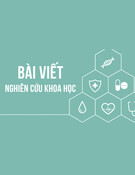

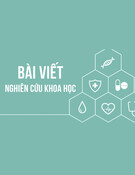






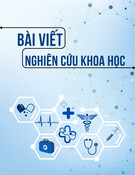

![Bài giảng Vi sinh vật: Đại cương về miễn dịch và ứng dụng [chuẩn nhất]](https://cdn.tailieu.vn/images/document/thumbnail/2025/20251124/royalnguyen223@gmail.com/135x160/49791764038504.jpg)
